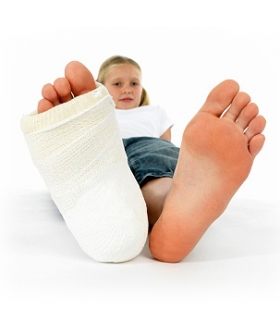Article at a Glance
If nobody in your family has broken a bone yet, count yourself lucky. Broken bones are one of the most common childhood injuries.
Luckily a child’s bones are different than an adult’s. Not only are they more flexible, but they also have a thicker covering. This makes their bones harder to break and heal faster. It is like nature planned ahead for their daredevil antics.
But even with these advantages, breaking a bone can still be one of the most painful and scary injuries your child has ever had. Learning what to do in advance will help you stay calm and allow you to be there for your child when you are needed most.
Is it really broken?
It can be hard to tell whether or not your child has broken a bone. The most common signs are a bump or change in shape of the bone, intense pain, bruising, or swelling. If the bone is broken, your child will probably not be able to move it or bear weight on it. Compound fractures are easier to spot because you can see the bone sticking through the skin.
But not every break will show all the symptoms. Even if you aren’t sure if it is a break, you will want to take your child in to be examined immediately.
When to call 911
If the bone is sticking through the skin or if the injury involves the hips, pelvis, upper leg, back, head, or neck, call 911. Do not move your child or try to straighten the bone.
Getting ready to go to the doctor’s office
If you think a bone is broken, call our office so you can bring your child in right away. But before you go, you will need to stabilize the bone. You can use a board or rolled up newspaper to make a splint. You can also help reduce the swelling by applying a cold compress to the wound. But don’t use ice on babies and toddlers. Their skin is more delicate and the ice can harm the skin.
If you have time, grab something that can help distract your child while at the doctor. Bringing a comfort object or pacifier can be a lifesaver. You may have to wait for doctor and it will seem like a painful eternity if your child has no distractions
But hold off on the snacks, drinks, or pain medication in case your child needs surgery. If possible, leave any other children with another adult. Your child will need your one-on-one attention.
At the doctor’s office
Once you arrive at the doctor’s, ask if you can give your child some pain medication. Then be ready to give lots of cuddles and to offer lots and lots of distraction. Let your child know that you will be there the whole time. Be sure to stay calm and upbeat.
Children usually do better during medical procedures when prepared ahead of time, so let your child know what to expect. Explain that the doctor will need to look at the injury and probably x-ray it. It might help to talk about what the exam could involve and explaining what an x-ray is. Try relating your explanation to things your child is already familiar with. For example, if your child likes robots or tractors, you can compare the x-ray machine to them. You can even try role-playing with a doll.
Depending on how old your child is you will want to be careful about how you share information. The word “broken” might be scary to a younger child. Instead just tell them that their bone is hurt. But older children might appreciate a more detailed explanation.
During the x-ray, try to make it a game or use something to distract your child. Most young children will not like to sit still during this part and are often scared by the equipment. Spending a little time to help them feel comfortable will help.
During the visit the doctor will be able to tell you if it is a break and if so, what kind of break. Generally childhood fractures don’t require surgery and take half the amount of time to heal as an adult fracture.
You can also ask about cast or splint options that are available. Sometimes you can get a waterproof liner that allows children to get the cast wet while bathing or swimming. Letting your child pick the color of the cast can also be a bright spot in an otherwise dreary experience. Luckily the pain usually lessens once the break has been secured in a cast or splint.
At home
Once you get home, it will probably take your child a few days to get comfortable. You can talk to your doctor about using acetaminophen or ibuprofen to help with the pain.
Learning how to sleep, play, and eat with the cast can also be a challenge. At night, children often accidentally hit themselves with their casts or it may keep them from sleeping in their preferred position. It can help soften the blow if you pad the cast by sandwiching it between pillows or covering it with a large, soft sock.
A large sock can also help keep a cast clean while eating or playing. It’s almost impossible to get applesauce out from underneath a cast and you would not believe the grime that can build up underneath those things!
But you will also be surprised at how quickly children adapt. It won’t be long before your child is running around and playing with the cast on like nothing happened. And the cast will be off before you even know it.
More Information
Frequently Asked Questions About Casts (kidshealth.org)
Children And Broken Bones (healthychildren.org)
Broken Bones (kidshealth.org)
